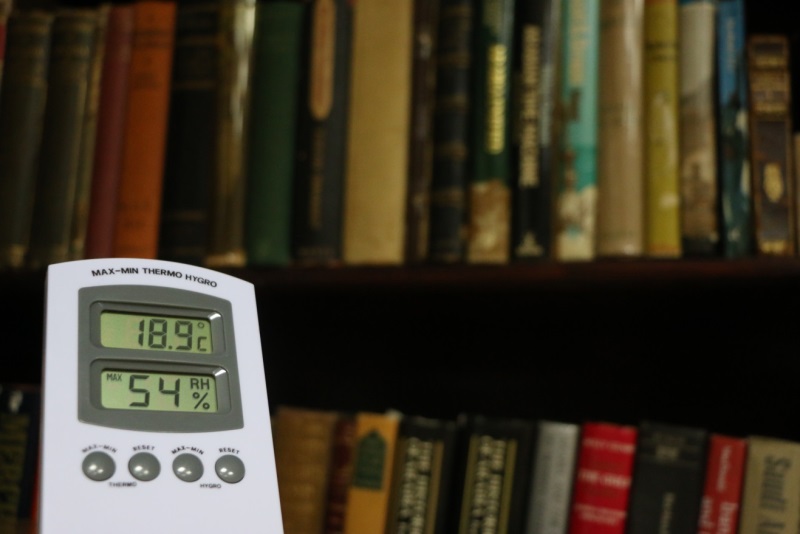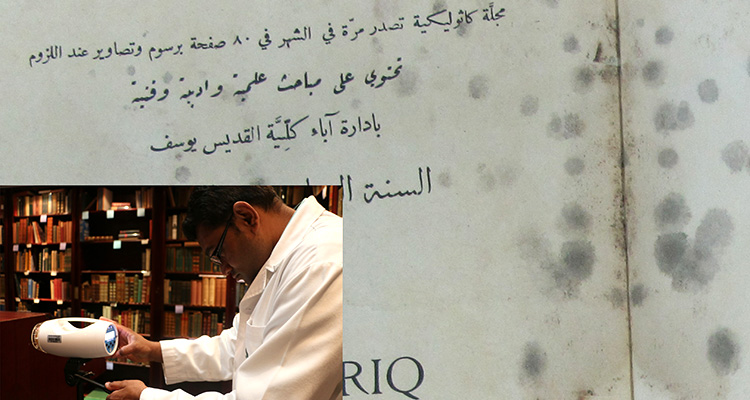Conservation and Preservation
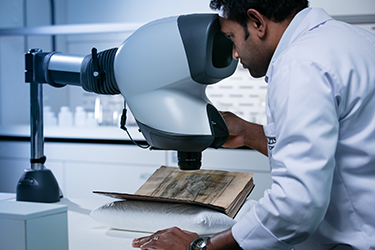
Books and manuscripts are inherently susceptible to deterioration from both natural and external causes. Moreover, due to changes in paper production, documents produced since the 19th century are even more fragile than older ones. The Library has a team of highly trained international experts, with laboratories equipped with world-class technology, dedicated to preserving the region’s cultural heritage for future generations. We can handle any kind of conservation and preservation activities in the following areas:
- Preventive conservation section
- Bio-deterioration analysis and treatment section
- Conservation section
- Materials analysis to support conservation actions as well as codicological studies
Preventive Conservation
Regular monitoring of all relevant information about the environmental conditions is one of the first steps in the implementation of preventive conservation strategy.
At QNL, we carefully monitor the temperature and the relative humidity in several ways. This data is retrieved by a computer in order to get a periodic view of the climatic condition of the air quality in all of the storage rooms and showcases.
Bio Deterioration Analysis and Treatment
The air around us is contains dust, mold spores, bacteria and insect eggs, all of which can threaten fragile items in the Qatar National Library collection. The Library's Preservation and Conservation Center determines the acceptable quantity of mold spores in the air and regularly monitors air quality to identify any increase, which could mean a higher risk of mold development. Bioluminescence tests are used to check for bio-contamination via surface contact.
Conservation

The staff members of the conservation center are highly trained in fields such as map conservation, paper and parchment conservation, and bookbinding conservation. Each item in the collection is analyzed individually, and conservation actions are based on the composition and condition of the item, as well as the quality of material available for conservation treatments.
There are two main types of deterioration threatening historical items:
Internal Deterioration
The natural deterioration process of paper and of some inks is a slow but irreversible process. Paper, particularly paper produced since the 19th century, naturally yellows and becomes very brittle. Some manuscript inks can cause paper and parchment to disintegrate, making the text unreadable.
External Deterioration
Poor environmental conditions, such as high temperatures, high or very low humidity, and fluctuations in both, as well as excessive light exposure, are damaging to paper and leather bindings. Rodents, insects, mold and bacteria can also cause documents to deteriorate very rapidly. Disasters such as floods, fires, and earthquakes can endanger entire collections. Threats aren’t always as dramatic, however—poor handling and inappropriate repairs can cause slow degradation as well.
Qatar National Library's experts will analyze the quality of the material of each item and the extent of any damage. We will then draw on our expertise to determine the extent of the preservation and conservation strategy. For example, the preservation lab has a machine that can very quickly fill in holes in a page with new paper, preventing further deterioration. We may also re-bind books and restore inks to improve readability and preserve the life of the item. We do not try to “fill in the blanks”: if there is text missing, we do not attempt to guess what was there and put it back in.
Material Analysis
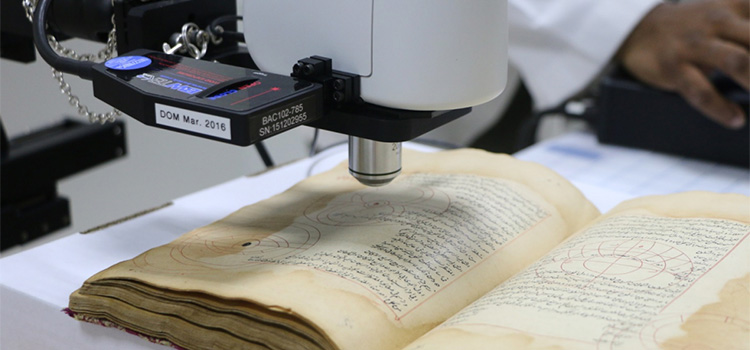
The QNL Preservation and Conservation Center is equipped with a state-of-the-art conservation laboratory that can analyze the quality of the material of each document. Using non-destructive, non-invasive analysis techniques, we can access information about each item’s material composition. This information is very useful for developing preservation strategies and conservation decisions, and increases our knowledge related to codicological studies (the study of manuscripts as historical objects).
IFLA PAC Regional Center for Arab Countries
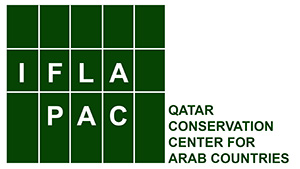
The IFLA Strategic Programme on Preservation and Conservation (PAC) was officially created in 1984 to focus efforts on issues of preservation and initiate worldwide cooperation for the preservation of library materials.
In line with its mission, since 2015, the Qatar National Library's Preservation and Conservation Center has been the IFLA PAC Regional Center for Arab countries and the Middle East, stressing the importance of international cooperation in this field. As a PAC Center, QNL offers the expertise of a fully trained international team and world-class conservation facilities.
Our objective is to create a collaborative professional network to improve preservation and conservation across the region. Our IFLA/PAC regional center’s role supports Arab libraries through a series of activities and initiatives to promote, disseminate and improve preservation and conservation practices. These include:
- Creating an international information and knowledge-sharing network
- Supporting and assisting Arab libraries with conservation issues: Qatar National Library and UNESCO project - Supporting Documentary Heritage Preservation in the Arab Region
- Fighting the trafficking and illegal circulation of documentary heritage (Himaya - حماية project)
- Producing and publishing materials related to preservation and conservation (in Arabic and English)
- Guiding the development of disaster plans
- Organizing courses, workshops and meetings
- Training Course on Book Binding Conservation, Doha, Qatar National Library
- Practical Methods for the Scientific Examination of Library Objects - Doha, Qatar National Library
- Practical Methods for the Scientific Examination of Library Objects - Rabat, Morrocco
- Practical Methods for the Scientific Examination of Library Objects - Muscat, Oman
- Afghanistan Preservation and Conservation E-Course - Illegal Trade of Antiquities: Protecting the Cultural Treasures of Afghanistan: This project focuses on preserving heritage in Afghanistan and combating illicit trafficking, in collaboration with the Alliance for the Restoration of Cultural Heritage (ARCH). It is available in English, Dari, and Pashto.
- Protect Cultural Heritage Through Films - Afghanistan series (available in English, Dari, and Pashto)
- Episode 1: Afghanistan's Rich History is a National Treasure
- Episode 2: Heritage Under Siege: Looting Destroys a Nation’s Future
- Episode 3: Preserving History: Teaching the Next Generation to Protect Their Cultural Legacy
- Translating IFLA's guidelines and documents on preservation and conservation into Arabic
- Translating IASA Standards, Recommended Practices and Strategies
- IASA-TC 03 - The Safeguarding of the Audiovisual Heritage: Ethics, Principles and Preservation Strategy
- IASA-TC 04 - Guidelines on the Production and Preservation of Digital Audio Objects
- IASA-TC 05 - Handling and Storage of Audio and Video Carriers
- IASA-TC 06 - Guidelines for the Preservation of Video Recordings
- IASA-TC06 A - Introduction
- IASA-TC06 B - Video Signal, Preservation Concepts, and Target Formats
- IASA-TC06 B App - Appendixes to section B.3
- IASA-TC06 C - Video Carriers and Signal Extraction (Replay/Playback)
- IASA-TC06 D - Planning, Setup, and Workflows for Video Digitization
- IASA-TC06 E - Bibliography
Resources
For more information on preservation and conservation, please see:
Publications
- IFLA's Principles for the Care and Handling of Library Materials - English Arabic Translation
Reports
Trafficking and the Circulation of Stolen Antiquities and Documentary Heritage in Afghanistan
Videos
Contact the IFLA PAC Center at QNL
For further information, especially if you are in one of the countries that are covered by our PAC regional center and you are interested in our activities, please do not hesitate to contact:
Tel: +974 4454 8147
PO Box: 5825, Doha – Qatar
Email: [email protected]
Seek Advice from a QNL Conservator
You or your family may have some old books and documents that you wish to preserve for future generations.
Some quick tips:
- Never use adhesive tape
- Gently remove dust periodically
- Make sure to store your documents in an air-conditioned room with a low risk of water leakage
For advice from a QNL expert about preserving or conserving your heritage material, please click below:

